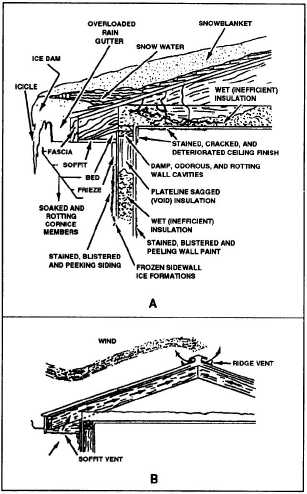outlet boxes and other utility connections in exposed
walls to minimize condensation on cold surfaces.
VAPOR BARRIER
Most building materials are permeable to water
vapor. This presents problems because considerable
water vapor can be generated inside structures. In cold
climates during cold weather, this vapor may pass
through wall and ceiling materials and condense in the
wall or attic space. In severe cases, it may damage the
exterior paint and interior finish, or even result in
structural member decay. For protection, a material
highly resistive to vapor transmission, called a vapor
barrier, should be used on the warm side of a wall and
below the insulation in an attic space.
Types
Effective vapor-barrier materials include asphalt
laminated papers, aluminum foil, and plastic films. Most
blanket and batt insulations include a vapor barrier on
one side, and some of them with paper-backed aluminum
foil. Foil-backed gypsum lath or gypsum boards are also
available and serve as excellent vapor barriers.
Some types of flexible blanket and batt insulations
have barrier material on one side. Such flexible
insulations should be attached with the tabs at their
sides fastened on the inside (narrow) edges of the studs,
and the blanket should be cut long enough so that the
cover sheet can lap over the face of the soleplate at the
bottom and over the plate at the top of the stud space.
However, such a method of attachment is not the
common practice of most installers.
When a positive seal is desired, wall-height rolls of
plastic-film vapor barriers should be applied over studs,
plates, and window and doorheaders. This system, called
“enveloping,” is used over insulation having no vapor
barrier or to ensure excellent protection when used over
any type of insulation. The barrier should be fitted
tightly around outlet boxes and sealed if necessary. A
ribbon of sealing compound around an outlet or switch
box minimizes vapor loss at this area. Cold-air returns,
located in outside walls, should be made of metal to
prevent vapor loss and subsequent paint problems.
Paint Coatings
Paint coatings cannot substitute for the membrane
types of vapor barriers, but they do provide some
protection for structures where other types of vapor
barriers were not installed during construction. Of the
various types of paint, one coat of aluminum primer
followed by two decorative coats of flat wall oil base
Figure 5-30.—Ice dams and protective ventilation.
paint is quite effective. For rough plasterer for buildings
in very cold climates, two coats of aluminum primer may
be necessary. A pigmented primer and sealer, followed
by decorative finish coats or two coats of rubber-base
paint, are also effective in retarding vapor transmission.
VENTILATION
Condensation of moisture vapor may occur in attic
spaces and under flat roofs during cold weather. Even
where vapor barriers are used, some vapor will probably
work into these spaces around pipes and other
inadequately protected areas and through the vapor
barrier itself. Although the amount might be
unimportant if equally distributed, it may be sufficiently
concentrated in some cold spots to cause damage. While
wood shingle and wood shake roofs do not resist vapor
movement, such roofings as asphalt shingles and built-
up roofs are highly resistant. The most practical method
of removing the moisture is by adequate ventilation of
roof spaces.
5-24

